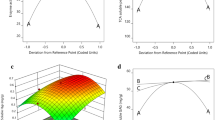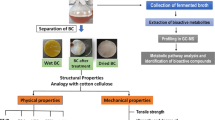Abstract
Main conclusion
An eco-friendly cell wall digestion strategy was developed to enhance the availability of nutritionally important bio molecules of edible microalgae and exploit them for cloning, transformation, and expression of therapeutic proteins.
Microalgae are the source for many nutritionally important bioactive compounds and potential drugs. Even though edible microalgae are rich in nutraceutical, bioavailability of all these molecules is very less due to their rigid recalcitrant cell wall. For example, the cell wall of Scenedesmus quadricauda CASA CC202 is made up of three layers comprising of rigid outer pectin and inner cellulosic layer separated by a thin middle layer. In the present investigation, a comprehensive method has been developed for the selective degradation of S. quadricauda CASA CC202 cell wall, by employing both mechanical and enzymatic treatments. The efficiency of cell wall removal was evaluated by measuring total reducing sugar (TRS), tannic acid–ferric chloride staining, calcoflour white staining, scanning electron microscopy (SEM), and Fourier transform infrared spectroscopy (FTIR) analysis. It was confirmed that the yield of TRS increased from 129.82 mg/g in 14 h from pectinase treatment alone to 352.44 mg/g by combined sonication and enzymatic treatment within 12 h. As a result, the combination method was found to be effective for the selective degradation of S. quadricauda CASA CC202 cell wall. This study will form a base for our future works, where this will help to enhance the digestibility and availability of nutraceutically important proteins.








Similar content being viewed by others
Abbreviations
- TRS:
-
Total reducing sugar
- SEM:
-
Scanning electron microscopy
- FTIR:
-
Fourier transform infrared spectroscopy
- PUFA:
-
Polyunsaturated fatty acid
- BBM:
-
Bold Basal Medium
References
Aaronson S, Berner T, Dubinsky Z (1980) Microalgae as source of chemicals and natural products. In: Shelef G, Soeder CJ (eds) Algae Biomass: Production and Use, Elsevier/North Holland Biomedical Press, Amsterdam, pp 576–601
Ahmed I, Zia MA, Hussain MA, Akram Z, Naveed MT, Nowrouzi A (2016) Bioprocessing of citrus waste peel for induced pectinase production by Aspergillus niger; its purification and characterization. J Radiat Res Appl Sci 9(2):148–154
Amano H, Noda H (1990) Proteins from protoplasts from red alga Porphyra yezoensis. Nippon Suisan Gakkaishi 56:1859–1864
Andrews B, Asenjo J (1987) Enzymatic lysis and disruption of microbial cells. Trends Biotechnol 5(10):273–277
Anemaet IG, Bekker M, Hellingwerf KJ (2010) Algal photosynthesis as the primary driver for a sustainable development in energy, feed, and food production. Mar Biotechnol 12(6):619–629
Arumugam M, Agarwal A, Arya M, Ahmed Z (2011) Microalgae: a renewable source for second generation biofuels. Curr Sci 100(8):1141–1142
Barrera DJ, Mayfield SP (2013) High-value recombinant protein production in microalgae. Handbook of microalgal culture: applied phycology and biotechnology, 2nd edn. Wiley, New York, pp 532–544
Becker E (2007) Micro-algae as a source of protein. Biotechnol Adv 25(2):207–210
Bewick D, Potter BA (1984) Chlorella: the emerald food. RoninPublishing, Berkeley
Bisalputra T, Weier T (1963) The cell wall of Scenedesmus quadricauda. American J Bot 50:1011–1019
Borines MG, de Leon RL, Cuello JL (2013) Bioethanol production from the macroalgae Sargassum spp. Bioresour Technol 138:22–29
Braun-Galleani S, Baganz F, Purton S (2015) Improving recombinant protein production in the Chlamydomonas reinhardtii chloroplast using vivid Verde Fluorescent Protein as a reporter. Biotechnol J 10(8):1289–1297
Burlew JS (1953) Current status of the large-scale culture of algae. Algal culture from laboratory to pilot plant Carnegie Institute of Washington Publication 600:3–23
Cariquist S (1956) On the occurrence of intracellular pecticwarts in compositae. Am J Bot 43:425–429
Ceci L, Lozano J (1998) Determination of enzymatic activities of commercial pectinases for the clarification of apple juice. Food Chem 61(1):237–241
Chisti Y, Moo-Young M (1986) Disruption of microbial cells for intracellular products. Enzyme Microbial Technol 8(4):194–204
Ciferri O (1983) Spirulina, the edible microorganism. Microbiol Rev 47(4):551
Copikova J, Cerna M, Novotna M, Kaasova J, Synytsya A (2001) Application of FT-IR spectroscopy in detection of food hydrocolloids confectionery jellies and in food supplements. Czech J Food Sci 19(2):51–56
Damásio ARdL, Maller A, Silva TMD, Jorge JA, Terenzi HF, Polizeli MdLTd (2011) Biotechnological potential of alternative carbon sources for production of pectinases by Rhizopus microsporus var. rhizopodiformis. Brazilian Arch Biol Technol 54(1):141–148
DuBois M, Gilles KA, Hamilton JK, Pt Rebers, Smith F (1956) Colorimetric method for determination of sugars and related substances. Anal Chem 28(3):350–356
Dumay J, Clément N, Morançais M, Fleurence J (2013) Optimization of hydrolysis conditions of Palmaria palmata to enhance R-phycoerythrin extraction. Bioresour Technol 131:21–27
Economou C, Wannathong T, Szaub J, Purton S (2014) A simple, low-cost method for chloroplast transformation of the green alga Chlamydomonas reinhardtii Methods. Mol Biol 1132:401–411
Eldalatony MM, Kabra AN, Hwang J-H, Govindwar SP, Kim K-H, Kim H, Jeon B-H (2016) Pretreatment of microalgal biomass for enhanced recovery/extraction of reducing sugars and proteins. Bioprocess Biosyst Eng 39(1):95–103
Fleurence J (1999) Seaweed proteins: biochemical, nutritional aspects and potential uses. Trends Food Sci Technol 10(1):25–28
Flores-Félix JD, Menéndez E, Marcos-García M, Celador-Lera L, Rivas R (2015) Calcofluor white, an alternative to propidium iodide for plant tissues staining in studies of root colonization by fluorescent-tagged rhizobia. J Adv Biol Biotechonol 2:65–70
Foster AS (1934) The use of tannic acid and iron chloride for staining cell walls in meristematic tissue. Stain Technol 9:91–92
Fry SC (1986) Cross-linking of matrix polymers in the growing cell walls of angiosperms. Ann Rev Plant Physiol 37(1):165–186
Fu C-C, Hung T-C, Chen J-Y, Su C-H, Wu W-T (2010) Hydrolysis of microalgae cell walls for production of reducing sugar and lipid extraction. Bioresour Technol 101(22):8750–8754
Galat A (1980) Study of the Raman scattering and infrared absorption spectra of branched polysaccharides. Acta Biochim Pol 27(2):135–142
Gantar M, Svirčev Z (2008) Microalgae and cyanobacteria: food for thought1. J Phycol 44(2):260–268
Gerken HG, Donohoe B, Knoshaug EP (2013) Enzymatic cell wall degradation of Chlorella vulgaris and other microalgae for biofuels production. Planta 237(1):239–253
Ginzberg A, Cohen M, Sod-Moriah UA, Shany S, Rosenshtrauch A, Arad SM (2000) Chickens fed with biomass of the red microalga Porphyridium sp. have reduced blood cholesterol level and modified fatty acid composition in egg yolk. J Appl Phycol 12(3–5):325–330
Goiris K, Muylaert K, Fraeye I, Foubert I, De Brabanter J, De Cooman L (2012) Antioxidant potential of microalgae in relation to their phenolic and carotenoid content. J Appl Phycol 24(6):1477–1486
Golding CG, Lamboo LL, Beniac DR, Booth TF (2016) The scanning electron microscope in microbiology and diagnosis of infectious disease. Sci Rep 6:26516. doi:10.1038/srep26516
Gross R, Schoneberger H, Gross U, Lorenzen H (1982) The nutritional quality of Scenedesmus acutus produced in a semi-industrial plant in peru. Berichte der Deutschen Botanischen Gesellschaft 95(1):323–331
Hannon M, Gimpel J, Tran M, Rasala B, Mayfield S (2010) Biofuels from algae: challenges and potential. Biofuels 1(5):763–784
Harun R, Danquah MK (2011) Enzymatic hydrolysis of microalgal biomass for bioethanol production. Chem Eng J 168(3):1079–1084
Hempel F, Lau J, Klingl A, Maier UG (2011) Algae as protein factories: expression of a human antibody and the respective antigen in the diatom Phaeodactylum tricornutum. PLoS One 6(12):e28424
Hornatowska J (2005) Visualisation of pectins and proteins by microscopy. STFI-Packforsk report No. 87/2005
Huo S, Wang Z, Cui F, Zou B, Zhao P, Yuan Z (2015) Enzyme-assisted extraction of oil from wet microalgae Scenedesmus sp. G4. Energies 8(8):8165–8174
Ingesson H, Zacchi G, Yang B, Esteghlalian AR, Saddler JN (2001) The effect of shaking regime on the rate and extent of enzymatic hydrolysis of cellulose. J Biotechnol 88(2):177–182
Kermanshahi-pour A, Sommer TJ, Anastas PT, Zimmerman JB (2014) Enzymatic and acid hydrolysis of Tetraselmis suecica for polysaccharide characterization. Bioresour Technol 173:415–421
Kim D-Y, Vijayan D, Praveenkumar R, Han J-I, Lee K, Park J-Y, Chang W-S, Lee J-S, Oh Y-K (2016) Cell-wall disruption and lipid/astaxanthin extraction from microalgae: Chlorella and Haematococcus. Bioresour Technol 199:300–310
Kumar S, Gupta R, Kumar G, Sahoo D, Kuhad RC (2013) Bioethanol production from Gracilaria verrucosa, a red alga, in a biorefinery approach. Bioresour Technol 135:150–156
Murdock JN, Wetzel DL (2009) FT-IR microspectroscopy enhances biological and ecological analysis of algae. Appl Spectrosc Rev 44(4):335–361
Murdock JN, Dodds WK, Wetzel DL (2008) Subcellular localized chemical imaging of benthic algal nutritional content via HgCdTe array FT-IR. Vib Spectrosc 48(2):179–188
Neto AMP, de Souza RAS, Leon-Nino AD, da Costa JDAA, Tiburcio RS, Nunes TA, de Mello TCS, Kanemoto FT, Saldanha-Corrêa FMP, Gianesella SMF (2013) Improvement in microalgae lipid extraction using a sonication-assisted method. Renew Energy 55:525–531
Park J-Y, Lee K, Choi S-A, Jeong M-J, Kim B, Lee J-S, Oh Y-K (2015) Sonication-assisted homogenization system for improved lipid extraction from Chlorella vulgaris. Renew Energy 79:3–8
Priyadarshani I, Rath B (2012) Commercial and industrial applications of micro algae—a review. J Algal Biomass Utln 3(4):89–100
Rice E, Crowden R (1987) An improved method for the extraction and electrophoresis of proteins and active enzymes from fucalean macroalgae (Phaeophyta). Phycol 26(2):235–246
Saito K, Takakuwa N, Oda Y (2004) Purification of the extracellular pectinolytic enzyme from the fungus Rhizopus oryzae NBRC 4707. Microbiol Res 159(1):83–86
Serot T, Courcoux P, Guillemineau F (1994) Extraction and partial characterization of protein from the green algae Ulva sp. Sciences des aliments 14(3):301–309
Shuler MLKF (2002) Bioprocess engineering, 2nd edn. PrenticeHall, NJ
Synytsya A, Čopiková J, Matějka P, Machovič V (2003) Fourier transform Raman and infrared spectroscopy of pectins. Carbohyd Pol 54(1):97–106
Talero E, García-Mauriño S, Ávila-Román J, Rodríguez-Luna A, Alcaide A, Motilva V (2015) Bioactive compounds isolated from microalgae in chronic inflammation and cancer. Mar Drugs 13(10):6152–6209
Vonshak A (1990) Recent advances in microalgal biotechnology. Biotechnol Adv 8(4):709–727
Wang M, Yuan W, Jiang X, Jing Y, Wang Z (2014) Disruption of microalgal cells using high-frequency focused ultrasound. Bioresour Technol 153:315–321
Yaakob Z, Ali E, Zainal A, Mohamad M, Takriff MS (2014) An overview: biomolecules from microalgae for animal feed and aquaculture. J Biol Res-Thessaloniki 21(1):1
Yoonan K, Kongkiattikajorn J (2005) A study of optimal conditions for reducing sugars production from cassava peels by diluted acid and enzymes. Kasetsart J Nat Sci 38:29–35
Acknowledgements
The work was supported by the grant from Department of Science and Technology—SERB, Government of India through the project entitled “SERB/F/8404/2025-16: Bioprospecting of microalgal resources for nutritionally important high value lipid production” to Arumugam. We are also grateful to Dr. K.G. Raghu and Mr. Salin Raj for fluorescence imaging at Agro-processing and Technology division, Dr. Prabhakar Rao P and Mrs. Soumya for SEM imaging at Material science and technology division, Dr. Karunakaran and Dr. Kaustabh kumar Maiti at Chemical Sciences and Technology Division and Dr. Leena P Devendra, Mrs. Meena at Microbial Processes and Technology Division, CSIR—National Institute for Interdisciplinary Science and Technology Division (NIIST), Thiruvananthapuram, Kerala, India for FTIR analysis. Authors also thank Department of Biotechnology (DBT), New Delhi for giving financial support for doctoral programme of Reshma.
Author information
Authors and Affiliations
Corresponding author
Ethics declarations
Conflict of interest
The authors declare that they have no conflict of interest.
Ethical approval
This article does not contain any studies with human participants or animals performed by any of the authors.
Electronic supplementary material
Below is the link to the electronic supplementary material.
Rights and permissions
About this article
Cite this article
Reshma, R., Arumugam, M. Selective degradation of the recalcitrant cell wall of Scenedesmus quadricauda CASA CC202 . Planta 246, 779–790 (2017). https://doi.org/10.1007/s00425-017-2732-6
Received:
Accepted:
Published:
Issue Date:
DOI: https://doi.org/10.1007/s00425-017-2732-6




